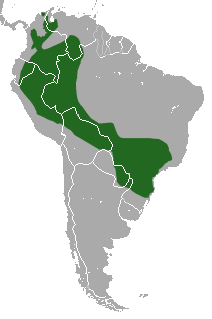Red wool pouch rat
| Red wool pouch rat | ||||||||||||
|---|---|---|---|---|---|---|---|---|---|---|---|---|

Red woolly rat ( Caluromys lanatus ) |
||||||||||||
| Systematics | ||||||||||||
|
||||||||||||
| Scientific name | ||||||||||||
| Caluromys lanatus | ||||||||||||
| ( Olfers , 1818) |
The red wool pouch rat ( Caluromys lanatus ), also known as the brown-eared wool pouch rat , lives in a wide band that runs diagonally through South America. It begins in central Colombia, includes western and southern Venezuela, includes eastern Ecuador, Peru and Bolivia and western Brazil, as well as eastern Paraguay and ends in southern Brazil.
features
The animals reach a head trunk length of 20 to 31.9 cm and a total length of 60 to 70 cm. The tail reaches an average of 140% of the length of the head. The weight of the medium-sized opossum species is between 300 and 520 g, with values well above the low value being an exception. The dense, woolly fur is light brown in color, sometimes with a gray or reddish tint and an orange tint on the shoulders, the limbs and on the head. A central dark stripe on the head is characteristic of the species. The large eyes are directed forward. The third of the prehensile tail close to the body is hairy, the rest is naked. In adaptation to a primarily herbivorous diet, the appendix and rectum are particularly long.
Way of life
The red woolly rat is nocturnal, solitary and occurs in damp forests, dry forests, gallery forests and tree-lined savannahs and can usually be found on shrubs and trees at heights of 5 to 15 meters above the ground. It feeds mainly on fruits and other vegetable matter. Stomach examinations revealed fig seeds and remains of ant trees ( Cecropia ), nightshade family and pepper ( Piper ). Small animals are also consumed, including beetle larvae, butterflies, hymenoptera and small vertebrates. Since the opossums also ingest nectar, they also act as pollinators for plants. Reproduction has hardly been researched so far. Females with pups in their pouch, usually three, were found in March, July, August and December.
Subspecies
There are five subspecies:
- Caluromys lanatus lanatus , in eastern Paraguay, southern Brazil, and the Argentine province of Misiones .
- Caluromys lanatus nattereri , in the Brazilian states of Mato Grosso , Mato Grosso do Sul and in the bordering Bolivia.
- Caluromys lanatus ochropus , found in southern Venezuela and western Brazil.
- Caluromys lanatus ornatus , in southern Colombia and eastern Ecuador, Peru and Bolivia.
- Caluromys lanatus vitalinus , in the Brazilian states of Minas Gerais , Espírito Santo and São Paulo .
Danger
The IUCN estimates the existence of the species as not endangered (Least Concern).
Individual evidence
- ^ A b Paul Smith: Handbook of the Mammals of Paraguay Vol 1: Marsupialia. Pages 7, 10-13.
- ^ A b Alfred L. Gardner (Ed.): Mammals of South America, Volume 1: Marsupials, Xenarthrans, Shrews, and Bats . The University of Chicago Press, Chicago 2015; ISBN 978-0-226-28240-4
- ↑ Caluromys lanatus in the endangered Red List species the IUCN 2015 Posted by: Costa, LP, Astua de Moraes, D. Brito, D., Lev, D. & Tarifa, T., 2015. Retrieved on February 20, 2017 .
